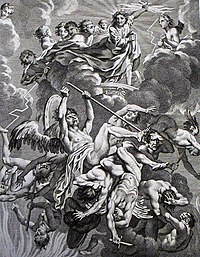

| Revelation 12 | |
|---|---|
 Apocalypse 19. Michael and the angel. Revelation 12:7-9. Scheits. Phillip Medhurst Collection | |
| Book | Book of Revelation |
| Category | Apocalypse |
| Christian Bible part | New Testament |
| Order in the Christian part | 27 |
Revelation 12 is the twelfth chapter of the Book of Revelation or the Apocalypse of John in the New Testament of the Christian Bible. The book is traditionally attributed to John the Apostle,[1][2] but the precise identity of the author remains a point of academic debate.[3] This chapter contains the accounts about the woman, the dragon, and the child, followed by the war between Michael and the dragon, then the appearance of the monster from the sea.[4] William Robertson Nicoll, a Scottish Free Church minister, suggests that in this chapter the writer has created a Christianised version of a Jewish source which "described the birth of the Messiah in terms borrowed from ... cosmological myths [such as] that of the conflict between the sun-god and the dragon of darkness and the deep".[5]
The original text was written in Koine Greek. This chapter is divided into 17 verses. The Vulgate version has 18 verses.[6]
Some early manuscripts containing the text of this chapter are among others:[7][a]



The King James Version refers to "a great wonder" [12] and the Revised Standard Version refers to "a great portent".[13] The Greek word used is σημεῖον, rendered sign in many other passages in the New Testament.[14] Anglican biblical commentator William Boyd Carpenter writes that "the word sign is preferable to wonder, both in this verse and in Revelation 12:3. It is the same word which is rendered signinRevelation 15:1. It is a sign which is seen: not a mere wonder, but something which has a meaning; it is not 'a surprise ending with itself', but a signal to arrest attention, and possessing significance; there is 'an idea concealed behind it'."[15]
The word rendered "dragon" - Ancient Greek: δράκων, drakōn - occurs 9 times (and 4 more in derivative forms)[17] in the New Testament, only in the Book of Revelation, where it is uniformly rendered as here: "dragon".[14] The word for diadem (Greek: διάδημα) occurs only three times in the New Testament, always in the Book of Revelation.

Michael (Mikha'elinDavid H. Stern's translation of the Bible into English) appears in the Book of Daniel as "the special patron or guardian angel of the people of Israel".[25]
|
| |
|---|---|
| Bible chapters (New Testament) |
|
| Places |
|
| Persons |
|
| Events/ Terms/ Phrases |
|
| Interpretation |
|
| Related |
|
| Manuscripts |
|
| Sources |
|